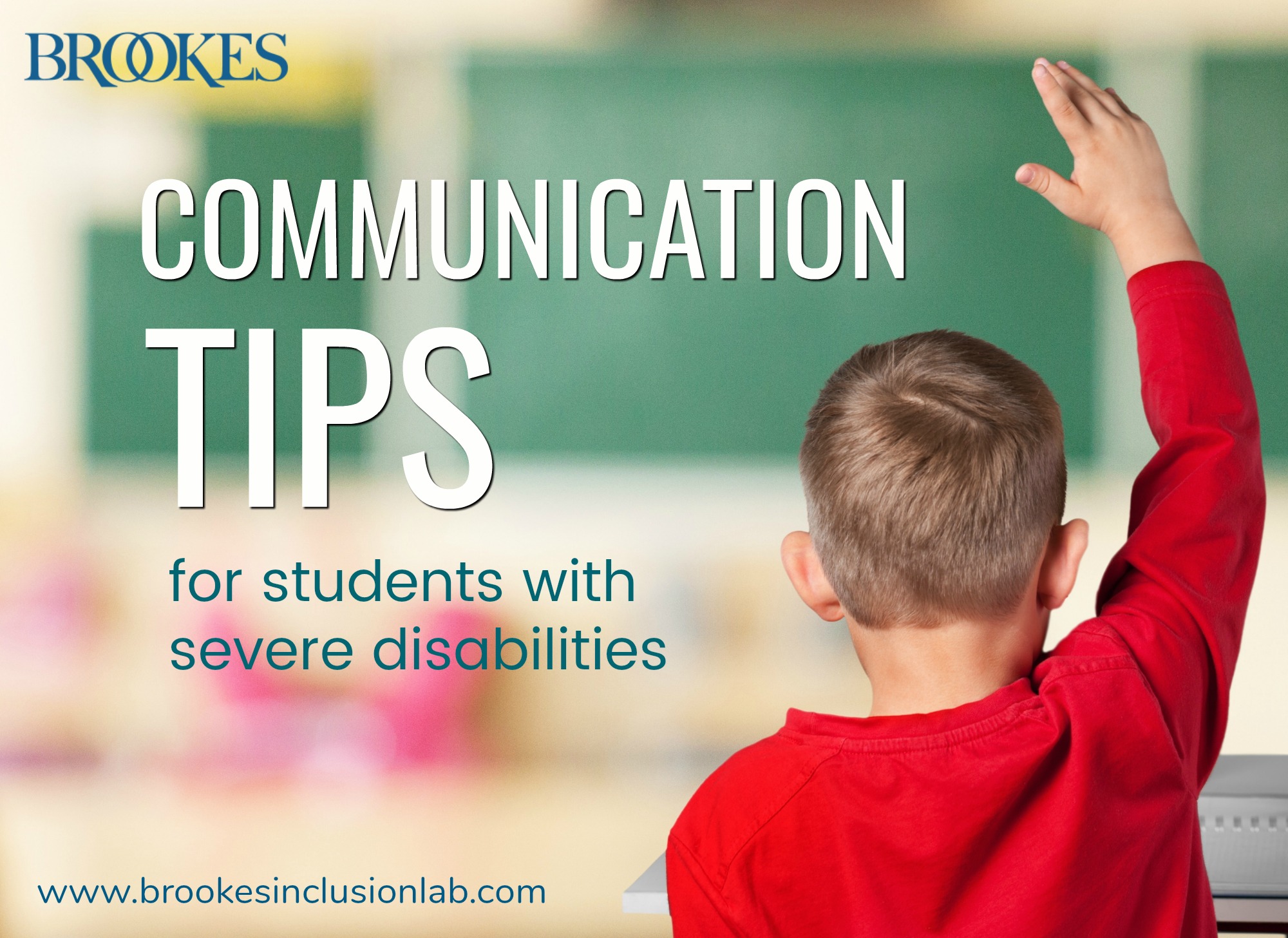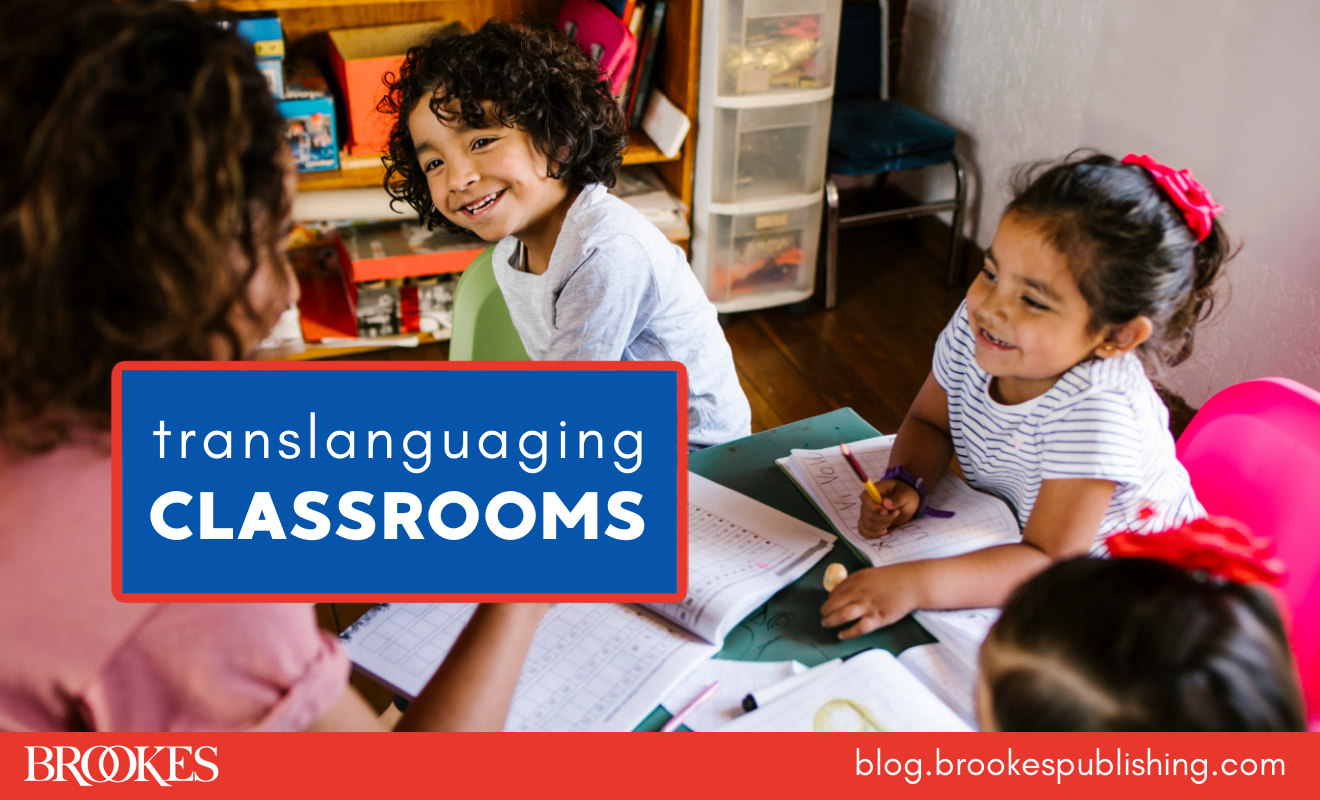Beyond Yes and No: Tips on Helping Students with Severe Disabilities Expand Their Communication Skills
July 30, 2019
Every learner has the right to communicate and have their needs met. For students with severe disabilities—as with all students—effective and meaningful communication means more than having a basic ability to express yes or no. That means teachers and other professionals on the support team should work together to help their students develop a broader range of communicative functions.
Today’s post, excerpted and adapted from Teaching Communication Skills to Students with Severe Disabilities, Third Edition, by June E. Downing, Amy Hanreddy, & Kathryn D. Peckham‑Hardin, offers tips on helping students with severe disabilities acquire, use, and increase their communication skills. Use these strategies in your own classroom to help your students make requests, ask questions, gain attention, and more!
Requesting
Request-making is a logical place to start. Students are usually highly motivated to make requests, and almost any activity or situation offers a chance to practice request-making. Here are a few examples of how to encourage and expand your students’ request-making skills:
- If a student who uses a wheelchair needs assistance at lunch or during another activity, don’t just assign a peer to help—encourage the student to make the selection. The student can choose a classmate by looking at or touching them, or by looking at a class photo and touching a picture of the peer they’d like to work with.
- Rather than just giving a student with a significant disability a particular item to use for an assignment, give the student a number of different materials to choose from.
- Make your reading activities more interactive. Allow the student to choose a book and make requests during the reading, such as whether a certain page should be read again.
- During a writing activity, let the student choose their preferred writing tool (vibrating pen, marker, glitter pen), the color of their paper, and where they would like to sit.
- When a student needs help with a specific activity, or needs a break from an activity already in progress, prompt them to request assistance from a teacher or peer.
Determining when students with limited means of communication are making requests instead of expressing interest in something can be challenging. You might have to ask a student to clarify their intent to differentiate requesting behavior from behavior meant to get a person’s attention or make a comment. Students can be taught that a certain behavior (such as making a manual sign, vocalizing the sound “wa,” or pointing to a symbol for want) can be used to make a request.
Rejecting or Protesting
All people have the right to say no to something they don’t want. Students who lack a conventional way to say no may voice their protests in any way that proves effective—including pinching, kicking, or screaming.
To prevent these challenging behaviors, equip your students with more conventional ways to reject an object or activity. If the student can’t verbally say, “No, I don’t want to do that,” or “No, I don’t like that,” teach them they can also say no through socially acceptable actions. These might include:
- Shaking their heads
- Pushing items away
- Pushing a red “no” button on a simple VOCA
- Closing their eyes
Gaining Attention
If a student doesn’t know how to get a person’s attention before communicating a message, their message probably won’t be received. Actively teach students with significant disabilities about a range of acceptable ways to gain the attention of a communication partner.
Here are seven ways to gain attention:
- Say the other person’s name, if possible
- Establish eye contact, if eye contact is comfortable for the student
- Move closer to the individual they want to communicate with
- Gently touch the other person’s arm
- Use a speech-generating device preprogrammed with an appropriate message such as “hey, can someone come over here and talk to me?”
- Vocalize
- Make a movement such as lifting your head
Students with significant disabilities might need specific instruction on the steps of initiating a conversation. Others may not be able to follow all the steps due to physical and sensory impairments and will need some adaptations. For example, if a student isn’t physically able to get closer to a potential communication partner, then potential partners can stay close to the student but not initiate an interaction. Then the student can initiate the interaction by following through on the other steps, such as selecting a potential listener and getting that person’s attention.
Engaging in Hellos, Goodbyes, and Other Social Niceties
Social niceties are more than just “nice”—they’re necessary skills we learn in order to feel welcome in any given social situation. Students with significant disabilities should be encouraged to learn and engage in these communication skills at school. Depending on their abilities, they can use smiles, looks, head movements, waves, or verbalizations such as “hi” and “bye.”
You can help promote these behaviors by:
- Modeling them
- Directing the student’s attention to others engaged in similar behaviors
- Making sure AAC devices, if needed, are readily available
- Serving as a temporary interpreter if a student’s sociable behavior isn’t clear to other students at first
- Prompting an appropriate response at first, and then fading the prompt as the student begins to exhibit mastery of the skill
Commenting
Everyone wants to be able to share their opinions with others—but comment-making is a form of communication that’s often overlooked for students with significant disabilities. Students often attempt to make comments, but many times their communication partners think they’re making requests because the attempts are done in unconventional ways. Here’s an example: Wes, a 10th-grade student, is looking with interest at a sculpture made by a classmate. His gaze could be intended as a comment—Wes could be thinking “that’s cool. I wish I could make something like that”—but his teacher could assume that his gaze is a request, and that he wants the statue brought to him. When this happens repeatedly, it can be very frustrating for the student.
In cases like these, it’s better to provide two or more possible interpretations to the student’s behavior so they have an opportunity to clarify their meaning. Here’s a vignette that demonstrates how this might work:
Julie, a third-grade student, is in art class. She has a pictorial system that allows her not only to request help and supplies (e.g., glue, a specific color of paint) but also lets her say, i like that, or i think it needs more stuff, when her classmates show her their art. To help Julie make comments, her teacher covers the pictures that signify requests so that Julie will only have access to the choices that signify comments. The teacher models using the pictorial symbols and then asks Julie to give her opinion. If Julie doesn’t respond, then the teacher tries to interpret her facial expressions and helps her make a response and state it out loud for her classmate. The teacher might say something like, “I think Julie is trying to tell you that she likes your picture.” She then asks Julie to confirm or deny if her statement is correct. Julie smiles, looks, and opens her mouth to say “yes” or gives a blank expression if she needs to correct the teacher. To help Julie develop her comment-making skills, the teacher provides her with several opportunities to comment on different classmates’ artwork at the end of each art class.
Asking for Information
Asking questions is an essential function of communication and an important strategy for learning new information. You can help students with disabilities to develop this communication skill by:
- Being sensitive to behavior that may indicate curiosity or interest and then following up with the student
- Refraining from providing too much information too soon, so the student’s curiosity is encouraged
- Developing class activities in which all students are prompted to ask questions
- Working with the student to develop a system that helps them ask questions (using AAC, physical prompts, etc.)
Here’s an example:
Mrs. Leary, a first-grade teacher, has created several methods for encouraging Nita to ask questions. One of these methods is incorporated in a sharing activity that happens every Monday afternoon and involves the whole class. Students bring items from home and discuss them with the class, and then classmates are encouraged to ask questions.
Nita uses a mercury switch attached to a multistep communicator to ask her question. Her sister records different questions at home every weekend so that Nita can participate in the Monday activity. The questions are generic enough to be meaningful regardless of what is shared (“Where did you say you got that?” “Can I see it up close?”). When the teacher asks if anyone has any questions, the paraeducator verbally cues Nita: “Remember to raise your hand if you have something to say.” If a verbal cue is not effective, then the educator touches Nita’s arm and gives her a more direct verbal cue: “Raise this arm.”
When Nita starts to raise her hand, the teacher calls on her first so that other students will hear her question and not repeat it. The mercury switch activates the recording as Nita raises her arm. If she doesn’t raise her arm sufficiently to activate the message, then the paraeducator can physically support her arm in this upright position until the message is activated.
Confirming or Denying
The ability to confirm or deny helps students avoid misinterpretations and breakdowns in interactions. Because students with significant disabilities often have difficulty communicating, asking them to confirm or deny whether they were correctly understood is not only extremely important, but also a sign of respect. Asking for confirmation lets students know that their attempts to communicate are important enough to be correctly understood.
Every day, there are many chances to help students with disabilities confirm or deny their communicative intent; teachers and peers just need to remember to check in with students and give them this opportunity. Students with severe disabilities can indicate whether they were correctly understood by:
- Saying “yes” or “no”
- Nodding or shaking their heads
- Smiling or frowning
- Pointing to or looking at a yes/no symbol
- Turning away from the communicative partner
- Following through with the desired activity or resisting an undesirable one
***
Use these strategies to expand your students’ communication skills, and you’ll empower them to develop relationships, get their needs met, and participate more fully in the social and academic life of your classroom. And for more guidance on supporting every student’s right to communicate…
CHECK OUT THE BOOK
 Teaching Communication Skills to Students with Severe Disabilities, Third Edition
Teaching Communication Skills to Students with Severe Disabilities, Third Edition
By June E. Downing, Ph.D., Amy Hanreddy, Ph.D., & Kathryn D. Peckham‑Hardin, Ph.D.,
with invited contributors
Get reliable information and practical guidance on the entire process of supporting communication for students of all ages, from assessing their communication skills to involving peers and adults in intervention.




Write a Comment
Your email address will not be published. Required fields are marked *
Post a Comment